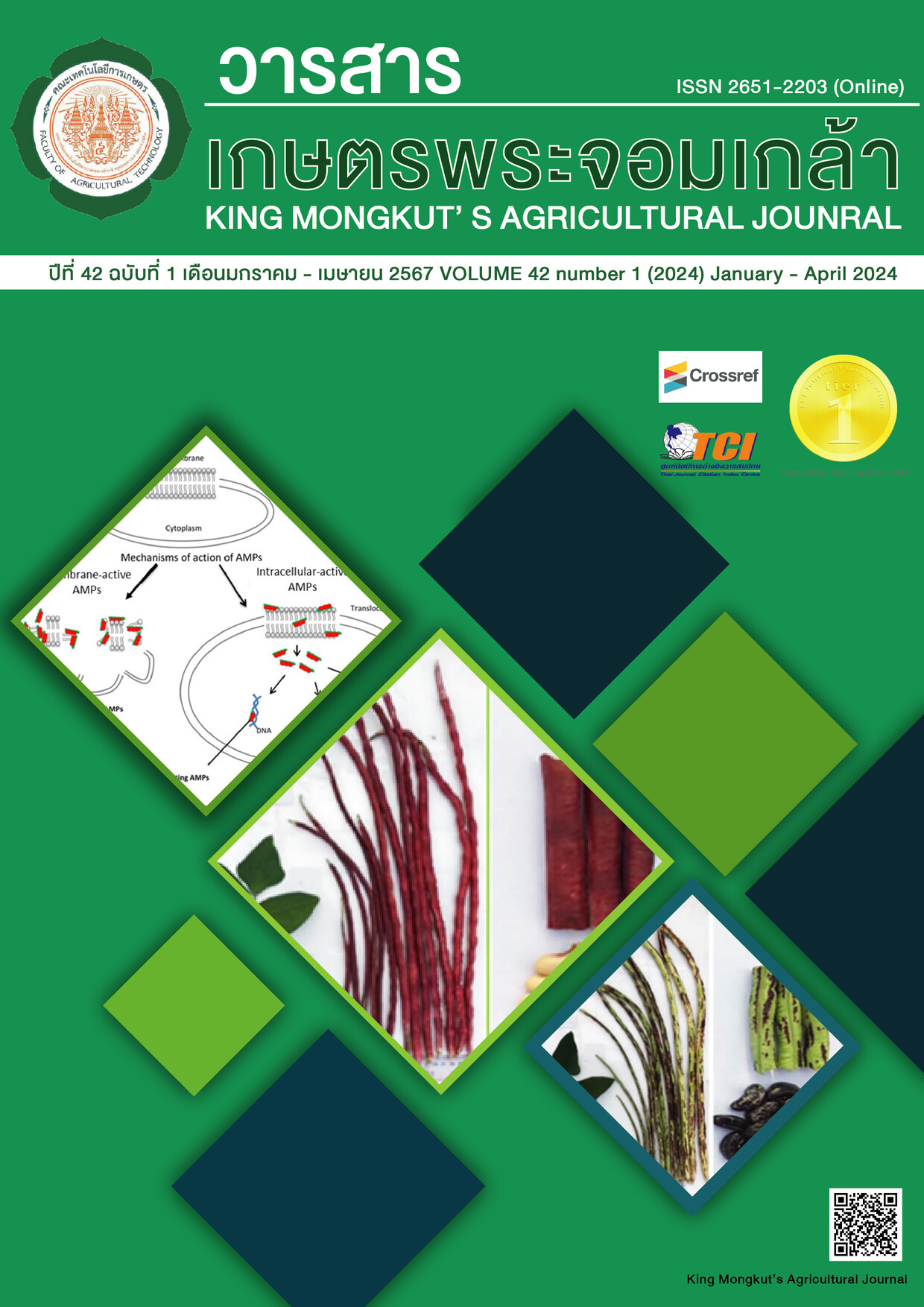ผลของเมทิลจัสโมเนตต่อคุณภาพ และปริมาณสารพฤกษเคมีในผลหม่อนพันธุ์กำแพงแสน 42 ภายหลังการเก็บเกี่ยว
Main Article Content
บทคัดย่อ
ผลหม่อนพันธุ์กำแพงแสน 42 เป็นหม่อนรับประทานผลสดที่อุดมไปด้วยคุณค่าทางอาหาร แต่มีอายุการเก็บรักษาสั้นเพียง 1-2 วัน ภายใต้สภาพอุณหภูมิห้อง ดังนั้นงานวิจัยนี้มีวัตถุประสงค์เพื่อศึกษาผลของเมทิลจัสโมเนตต่อคุณภาพ และปริมาณสารพฤกษเคมีในผลหม่อนพันธุ์กำแพงแสน 42 ภายหลังการเก็บเกี่ยว โดยรมผลหม่อนด้วยเมทิลจัสโมเนตที่ระดับความเข้มข้น 0 (ชุดควบคุม) 10 และ 20 µmolL-1 ที่อุณหภูมิ 20 องศาเซลเซียส เป็นระยะเวลา 6 ชั่วโมง จากนั้นเก็บรักษาที่อุณหภูมิ 10 ± 2 องศาเซลเซียส ความชื้นสัมพัทธ์ร้อยละ 90 ± 2 นาน 8 วัน ผลการทดลองพบว่าการรมผลหม่อนด้วยเมทิลจัสโมเนตที่ระดับความเข้มข้น 10 µmolL-1 มีประสิทธิภาพในการชะลอการสูญเสียน้ำหนัก และผลหม่อนที่รมด้วยเมทิลจัสโมเนตทุกระดับความเข้มข้นมีแนวโน้มลดการเกิดโรคได้ดีกว่าชุดควบคุม แต่ไม่แตกต่างกันทางสถิติ นอกจากนี้การรมผลหม่อนด้วยเมทิลจัสโมเนตที่ระดับความเข้มข้น 10 µmolL-1 มีปริมาณสารพฤกษเคมีและกิจกรรมการต้านอนุมูลอิสระเพิ่มขึ้นโดยมีปริมาณกรดแอสคอบิค และปริมาณสารประกอบฟีนอลทั้งหมดเพิ่มมากกว่าสิ่งทดลองอื่น ๆ อย่างมีนัยสำคัญยิ่ง (p< 0.01) ส่วนการรมผลหม่อนด้วยเมทิลจัสโมเนตที่ระดับความเข้มข้น 20 µmolL-1 มีการเปลี่ยนแปลงสีเพิ่มขึ้นอย่างมีนัยสำคัญ (p< 0.05) ทำให้มีปริมาณแอนโทไซนินมากที่สุด จากผลการทดลองนี้แสดงให้เห็นว่าการใช้เมทิลจัสโมเนตมีประสิทธิภาพในการรักษาคุณภาพ และเพิ่มปริมาณสารพฤกษเคมีในผลหม่อนพันธุ์กำแพง 42 ภายหลังการเก็บเกี่ยวได้
Article Details

อนุญาตภายใต้เงื่อนไข Creative Commons Attribution-NonCommercial-NoDerivatives 4.0 International License.
วารสารเกษตรพระจอมเกล้า
เอกสารอ้างอิง
Brand-Williams, W., Cuvelier, M. E., & Berset, C. (1995). Use of free radical method to evaluate antioxidant activity. LWT-Food Science Technology, 28, 25-30.
Butkhup, L. (2006). Mulberry fruits within the berry family contain high quantities of antioxidants. MSU Research Digest, 1(3), 41- 47. (in Thai).
Cheung, L. M., Cheung, P. C., & Ooi, V. E. (2003). Antioxidant activity and total phenolic of edible mushroom extract. Journal of Agricultural and Food Chemistry, 81, 249-255.
Deshi, V., Homa, F., Tokala, V. Y., Mir, H., Aftab, M. A., & Siddiqui, M. W. (2021). Regulation of pericarp browning in cold-stored litchi fruit using methyl jasmonate. Journal of King Saud University-Science, 33, 101445.
Gimenez, M. J., Serrano, M., Valverde, J. M., Martinez-Romero, D., Castillo, S., Valero, D., & Guillen, F. (2017). Preharvest salicylic acid and acetylsalicylic acid treatments preserve quality and enhance antioxidant systems during postharvest storage of sweet cherry cultivars. Journal of the Science of Food and Agriculture, 97, 1220-1228.
Ho, T. T., Murthy, H. N., & Park, S. Y. (2020). Methyl jasmonate induced oxidative stress and accumulation of secondary metabolites in plant cell and organ cultures. International Journal of Molecular Sciences, 21(3), 18.
Horwitz, W. (2000). Official methods of AOAC international. 16th ed. Gaithersburg MD.
Huang, X., Li, J., Shang, H., & Meng, X. (2015). Effect of methyl jasmonate on the anthocyanin content and antioxidant activity of blueberries during cold storage. Journal of the Science of Food and Agriculture, 95, 337-343.
Huang, Y. P., & Lai, H. M., (2016). Bioactive compounds and antioxidative activity of colored rice bran. Journal of Food and Drug Analysis, 24, 564-574.
Khan, M. A., Rahman, A. A., Islam, S., Khandokhar, P., Parvin, S., Islam, M. B., Hossain, M., Rashid, M., Sadik, G., Nasrin, S., Mollah, M. N. H., & Alam, H. M. K. (2013). A comparative study on the antioxidant activity of methanolic extracts from different parts of Morus alba L. (Moraceae). BMC Research Notes, 6, 24.
Lv, J., Zhang, M., Zhang, J., Ge, Y., Li, C., Meng, K., & Li, J. (2018). Effect of methyl jasmonate on expression of genes involved in ethylene biosynthesis the signaling pathway during postharvest ripening of apple fruit. Scientia Horticulturae, 229, 157-166.
Ozkan, Y., Ucar, M., Yildiz, K., & Ozturk, B. (2016). Pre-harvest gibberellic acid (GA3) treatments play an important role on bioactive compounds and fruit quality of sweet cherry cultivars. Scientia Horticulturae, 211, 358-362.
Ozturk, A., Yildiz, K., Ozturk, B., Karakaya, O., Gun, S., Uzum, S., & Gondogdu, M. (2019). Maintaining postharvest quality of medlar (Mespilus germanica) fruit using modified atmosphere packaging and methyl jasmonate. LWT-Food Science Technology, 111, 117-124.
Priya, S. (2012). Medicinal values of mulberry -An overview. Journal of Pharmacy Research, 5(7), 3588-9356.
Roe, J. H., Mary, B. M., Oesterling, M. J., & Charlotle, M. D. (1948). The determination of dike to L-gulonic acid, dehydro-L-ascorbic acid and L-ascorbic acid in the same tissue extract by 2,4 -Dinitrophenyl hydrazine method. Journal of Biological Chemistry, 174, 201-208.
Saini, R. S., Sharma, K. D., Kaushik, R. A., & Dhankhar, O. P. (2006). Laboratory Manual Analytical Techniques in Horticulture. IST Edition. Agrobios.
Sharma, P., Jha, A. B., Dubey, R. S., & Pessarakli, M. (2012). Reactive oxygen species, oxidative damage, and antioxidative defense mechanism in plants under stressful conditions. Journal of Botany, 2012, 1-26.
Siripanich, J., & Romphophak, T. (2006). Postharvest Technology of Fruits And Vegetables: Academic Publishing. 3rd ed. Kasetsart University, Kamphaeng Sane Campus, The National Agricultural Extension and Training Office. (in Thai).
Tzortzakis, N., Chrysargyris, A., Sivakumar, D., & Loulakakis, K. (2016). Vapour or dipping applications of methyl jasmonate, vinegar and sage oil for pepper fruit sanitation towards grey mould. Postharvest Biology Technology, 118, 120-127.
Valenzuela-Riffo, F., Zuniga, P. E., Morales-Quintana, L., Lolas, M., Caceres, M., & Figueroa, C. R. (2020). Priming of defense systems and upregulation of MYC2 and JAZ1 genes after Botrytis cinerea inoculation in methyl jasmonate-treated strawberry fruits. Planis-Basel, 9(4), 447.
Valverde, J. M., Gimenez, M. J., Guillen, F., Valero, D., Martinez-Romero, D., & Serrano, M. (2015). Methyl salicylate treatments of sweet cherry trees increase antioxidant systems in fruit at harvest and during storage. Postharvest Biology Technology, 109, 106-113.
Wang, H., Wu, Y., Yu, R., Wu, C., Fan, G., & Li, T. (2019). Effect of postharvest application of methyl jasmonate on physicochemical characteristics and antioxidant system of blueberry fruit. Scientia Horticulturae, 258, 1-8.
Wang, K., Jin, P., Han, L., Shang, H., Tang, S., Rui, H., & Zheng, Y. (2014). Methyl jasmonate induces resistance against Penicillium citrinum in Chinese bayberry by priming of defense responses. Postharvest Biology Technology, 98, 90-97.
Wolucka, A. B., Goossens, A., & Inze, D. (2005). Methyl jasmonate stimulates the de novo biosynthesis of vitamin C in plant cell suspensions. Journal of Experimental Botany, 56 (419), 2527-2538.
Wei, J., Wen, X., & Tang, L. (2017). Effect of methyl jasmonic acid on peach fruit ripening progress. Scientia Horticulturae, 220, 206-213.


